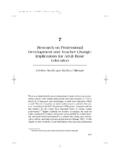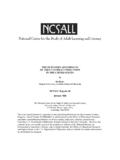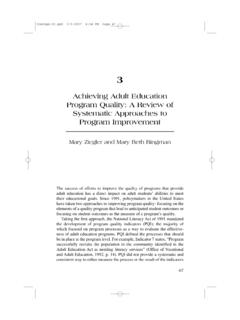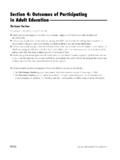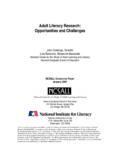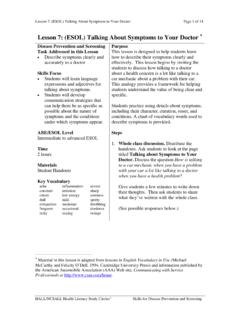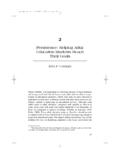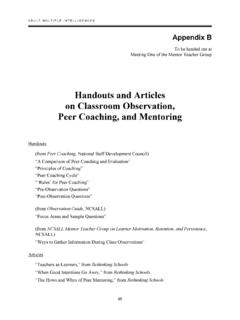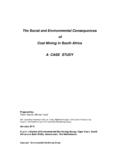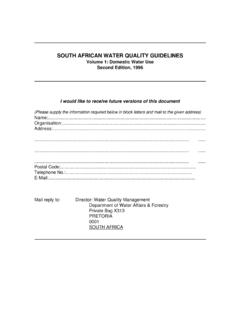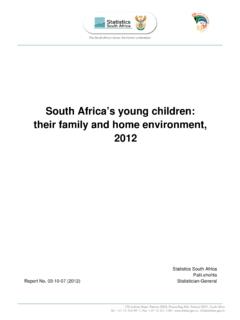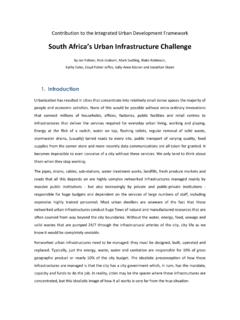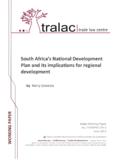Transcription of Adult Basic Education and Training in South Africa
1 2859 Adult Basic Education and Trainingin South AfricaVeronica McKayThe Republic of South Africa73 can be classified as a middle-income country,or a country with one foot in the first world and one foot in the developingworld. South Africa has a highly sophisticated production and commercialinfrastructure, and high gross domestic product and gross national product,which exist alongside high levels of poverty. South Africa has a low level of literacy, which cannot be viewedindependently of the apartheid policies that were in place prior to democ-ratization in 1994, inseparable from the developed developing context ofthe country.
2 The implications of apartheid were far-reaching and served toentrench inequalities and poverty along racial (and gender) lines. Theseinequalities affected the delivery of services such as water and sanitation,and also affected the system of Education . As a result, according to 2001census figures (Statistics South Africa , 2001), million adults (16% of73 South Africa is situated at the southernmost point of the African continent, borderingNamibia, Botswana, Zimbabwe, and Mozambique and surrounding the kingdoms ofSwaziland and Lesotho. Its total land area is 1,219,090 km2. 2/1/2007 2:47 PM Page 285286 MCKAYthe total population above the age of 15) have had no schooling and maybe considered illiterate.
3 A further million (32%) have not completedprimary school and may be considered in need of compensatory basiceducation. The majority of these adults are found in rural areas. About24% of Africans, 10% of coloreds, 747% of Indians, and 1% of Whitesover the age of 20 years are illiterate (Aitchison, Houghton, & Baatjes,2000). After the first democratic elections in South Africa , the new govern-ment faced a number of challenges, not the least being the high number ofadults who were functionally illiterate. There were many unemployedpeople whose levels of literacy were such that they were virtually unem-ployable due to the competition for the small number of available jobsrequiring little or no literacy skills.
4 In addition, low literacy was associ-ated with poverty and a low level of entrepreneurship in both the formaland informal on its vision of providing a better life for all South Africans, thenew government s Reconstruction and Development Policy75(AfricanNational Congress [ANC], 1994) placed great emphasis on communitydevelopment, in which Adult literacy and community development werelinked. In addition, the new constitutional and legislative framework (dis-cussed later) states that Adult Basic Education (ABE) is integral to SouthAfrica s economic growth and development. All key educational policydocuments now mention goal of this chapter is to describe the integration of Education andtraining in the Adult Basic Education and Training (ABET) system in SouthAfrica.
5 I first discuss the relationship of apartheid, poverty, and health tothe status of Adult literacy. Then, I discuss the policy and legislative frame-works related to Adult literacy, followed by a discussion of the role ofteachers in ABET. Finally, I show how in light of the aforementioned, anendeavor was made to provide Basic literacy as part of a national literacyprogram in South terms of apartheid legislation, South Africans were divided along racial lines intoAfrican, Asian, and White. Coloreds referred to children of any racial combination of theaforementioned categories. The categories are still used in certain circumstances to moni-tor employment equity was the only reconstruction and development program project that receivedno funding at all (Aitchison et al.)
6 , 2000). 2/1/2007 2:47 PM Page 286 APARTHEID AND ILLITERACYH istory of ApartheidOne of the Nationalist government s first acts after coming to power in1948 was to appoint a commission to formulate the principles and aims ofeducation for Natives76as an independent race (Troup, 1976). Pursuant tothe recommendations of the commission, the government formulated itslegislation in the Bantu Education Act of 1953. The government designedthis Act to give Africans77an Education conforming to their needs andopportunities as a separate community. Schooling was to be Bantu-ized78:The commission proposed low-quality, separate schooling for Africans,who would be trained for subordination.
7 The philosophy that informed this Act may be gleaned from the wordsof the Minister of Native Affairs, articulated during a debate in September1953:When I have control of native Education , I will reform it so that the nativeswill be taught from childhood to realise that equality with Europeans79isnot for them .. People who believe in equality are not desirable teachersfor natives. (Troup, 1976, p. 22) Apartheid Education was designed specifically to enforce obedience, com-munal loyalty, ethnic divisions, acceptance of allocated social roles, andidentification with rural culture. In the words of the Minister of NativeAffairs:There is no place for him [the black child] in the European [white SouthAfrican] community above the level of certain forms of labour.
8 Untilnow he has been subject to a school system which drew him away from hisown community and misled him by showing him the green pastures ofEuropean society in which he is not allowed to graze. (Verwoerd, cited inTroup, 1976, p. 22) Basic Education AND Training IN South AFRICA28776 Here referring to Blacks in general, and Africans in racial categorization implies those South Africans classified as Black but notIndian, Asian, or so-called meaning Black in this context referred to 2/1/2007 2:47 PM Page 287 The specific aim of apartheid and apartheid Education was to keepAfricans in a position of subservience and ignorance.
9 In attempting to pre-pare the African child for a future as hewers of wood and drawers ofwater (Verwoerd, cited in Troup, 1976), the apartheid master plan con-trolled economically, socially, psychologically, and spiritually theeducation of Black South Africans. This left African parents with twooptions: exposing their children to inferior Bantu Education , or givingthem no Education at all. Troup (1976) stated that because:only one African child in every two of school-going age was actuallyattending school, it was understandable that parents were unwilling to giveup an opportunity to get even some inferior Education for those luckyenough to have the opportunity.
10 (p. 22)The lack of compulsory Education , and the fact that the schools were sites ofthe liberation struggle, meant that many children did not attend or had dis-rupted attendance between 1976 and 1994, leaving many without Education ,thus contributing to the massive need for ABET within the the government established democracy in South Africa , theliteracy situation was still dismal: The statistics on the number of peoplewho need a Basic Education fluctuate depending on who is counting andwhat yardstick is used to measure and define literacy. With 11 officiallanguages, the difficulty of defining literacy is compounded.
